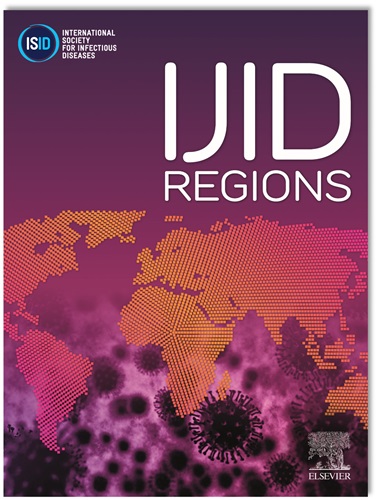Confirmatory mapping for lymphatic filariasis a decade after baseline endemicity assessment in highly urbanized settings of Lagos, Nigeria
IF 4.3
2区 医学
Q1 INFECTIOUS DISEASES
引用次数: 0
Abstract
Objectives
We conducted a confirmatory mapping survey to verify previous survey results, which suggested that lymphatic filariasis is endemic in some parts of Lagos State, Nigeria.
Methods
Finger-prick blood samples were collected from 2787 children aged 7-16 years in six local government areas (LGAs) across 153 targeted schools. Circulating filarial antigen (CFA) levels were measured using the filaria test strip, and LGAs were classified as endemic if there were up to three positive cases (d = 3).
Results
Children who tested positive for CFA were detected in all the six endemic LGAs, surpassing the critical cutoff; Surulere (d = 5, 1.36%, 95% confidence interval [CI] 0.5-3.2%), Mushin (d = 9, 1.9%, 95% CI 0.9-3.7%), Kosofe (d = 10, 1.6%, 95% CI 0.8-3.1%), Oshodi (d = 8, 1.6%, 95% CI 0.8-3.3%), Eti-Osa (d = 9, 2.60%, 95% CI 1.3-5.1%), and Ikorodu (d = 14, 3.0%, 95% CI 1.7-5.0%). All children who tested positive for CFA were ivermectin-naïve, and bed net ownership (14, 25.5%, P = 0.39) and use (7, 50.0%, P = 0.85) was low. About 29% (0-44%) of children who tested positive for CFA are likely to have acquired infection locally, and 71% (55.6-100%) could have acquired infection locally or elsewhere.
Conclusions
Our findings underscore the possibilities of local and imported infections and justify the need to reintroduce mass drug administration, optimize delivery of insecticide-treated bed nets, and extend confirmatory mapping to areas previously classified as non-endemic.
尼日利亚拉各斯高度城市化地区基线流行评估十年后淋巴丝虫病的确认性制图
目的:我们进行了一项确认性测绘调查,以验证先前的调查结果,该结果表明淋巴丝虫病在尼日利亚拉各斯州的一些地区流行。方法:采集153所目标学校6个地区7 ~ 16岁儿童2787例手指刺血样本。使用丝虫病试纸(FTS)检测循环丝虫病抗原(CFA)水平,如果有多达3例阳性病例(d=3),则将LGAs归类为地方性流行。结果:6例地方性lga均检出CFA阳性患儿,均超过临界临界值;Surulere (d = 5, 1.36%, 95%置信区间0.5 - -3.2%),Mushin (d = 9, 1.9%, 95% CI 0.9 -3.7%, Kosofe (d = 10, 1.6%, 95%置信区间0.8 - -3.1%),Oshodi (d = 8, 1.6%, 95%置信区间0.8 - -3.3%),Eti-Osa (d = 9, 2.60%, 95%置信区间1.3 - -5.1%),和Ikorodu (d = 14 3.0%, 95%置信区间1.7 - -5.0%)。所有CFA阳性儿童均为ivermectin-naïve,蚊帐拥有率(14.25.5%,p=0.39)和使用率(7.50.0%,p=0.85)均较低。约29%(0-44%)的CFA阳性儿童可能是本地获得性感染,71%(55.6-100%)可能是本地或其他地方获得性感染。结论:我们的研究结果强调了本地和输入性感染的可能性,并证明有必要重新引入MDA,优化ITN的提供,并将确认性制图扩展到以前被归类为非流行的地区。
本文章由计算机程序翻译,如有差异,请以英文原文为准。
求助全文
约1分钟内获得全文
求助全文
来源期刊
CiteScore
18.90
自引率
2.40%
发文量
1020
审稿时长
30 days
期刊介绍:
International Journal of Infectious Diseases (IJID)
Publisher: International Society for Infectious Diseases
Publication Frequency: Monthly
Type: Peer-reviewed, Open Access
Scope:
Publishes original clinical and laboratory-based research.
Reports clinical trials, reviews, and some case reports.
Focuses on epidemiology, clinical diagnosis, treatment, and control of infectious diseases.
Emphasizes diseases common in under-resourced countries.

 求助内容:
求助内容: 应助结果提醒方式:
应助结果提醒方式:


